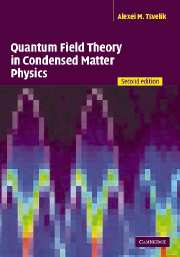Book contents
- Frontmatter
- Contents
- Preface to the first edition
- Preface to the second edition
- Acknowledgements for the first edition
- Acknowledgements for the second edition
- I Introduction to methods
- 1 QFT: language and goals
- 2 Connection between quantum and classical: path integrals
- 3 Definitions of correlation functions: Wick's theorem
- 4 Free bosonic field in an external field
- 5 Perturbation theory: Feynman diagrams
- 6 Calculation methods for diagram series: divergences and their elimination
- 7 Renormalization group procedures
- 8 O(N)-symmetric vector model below the transition point
- 9 Nonlinear sigma models in two dimensions: renormalization group and 1/N-expansion
- 10 O(3) nonlinear sigma model in the strong coupling limit
- II Fermions
- III Strongly fluctuating spin systems
- IV Physics in the world of one spatial dimension
- Select bibliography
- Index
6 - Calculation methods for diagram series: divergences and their elimination
Published online by Cambridge University Press: 05 May 2010
- Frontmatter
- Contents
- Preface to the first edition
- Preface to the second edition
- Acknowledgements for the first edition
- Acknowledgements for the second edition
- I Introduction to methods
- 1 QFT: language and goals
- 2 Connection between quantum and classical: path integrals
- 3 Definitions of correlation functions: Wick's theorem
- 4 Free bosonic field in an external field
- 5 Perturbation theory: Feynman diagrams
- 6 Calculation methods for diagram series: divergences and their elimination
- 7 Renormalization group procedures
- 8 O(N)-symmetric vector model below the transition point
- 9 Nonlinear sigma models in two dimensions: renormalization group and 1/N-expansion
- 10 O(3) nonlinear sigma model in the strong coupling limit
- II Fermions
- III Strongly fluctuating spin systems
- IV Physics in the world of one spatial dimension
- Select bibliography
- Index
Summary
In this chapter we consider several typical diagrams in the diagram expansion of the theory (5.1) and discuss certain general problems concerning perturbation expansions in QFT.
The correlation functions are represented as infinite sums and the first thing one should do is to check whether these sums are convergent. But it turns out that even individual members of these sums are often divergent! As we shall learn, there are divergences of two sorts: ultraviolet and infrared. In the first case the integrals diverge at large frequencies and momenta, and in the second case at small. Ultraviolet divergences appear in those field theories where the bare particle spectrum is unbounded. Their removal presents a severe ideological problem in high energy physics, where the unbounded spectrum ∈2 = p2c2 + (mc2)2 follows from the Lorentz invariance. In models of condensed matter physics, ultraviolet divergences present not a problem but a nuisance. Their presence indicates that the continuum description is incomplete, i.e. the behaviour of long-wavelength excitations depends on shorter length scales. It is certainly a nuisance, because the description becomes nonuniversal. Usually it is much easier to write down a continuous field theory; for this purpose one can employ quite general arguments, ones based on symmetry requirements, for example. It is really a disappointment when this beautiful castle built from pure ideas crumbles, and it turns out that a realistic description requires a careful study of processes occurring on the lattice scale.
Information
- Type
- Chapter
- Information
- Quantum Field Theory in Condensed Matter Physics , pp. 48 - 55Publisher: Cambridge University PressPrint publication year: 2003
